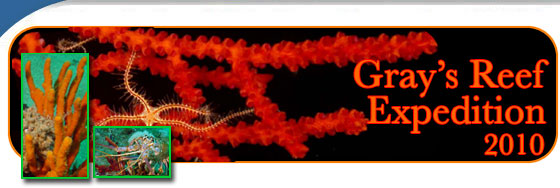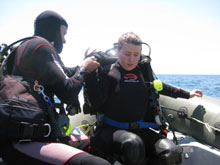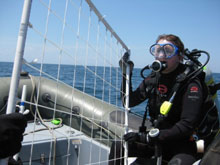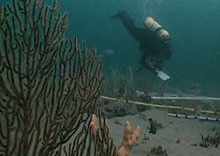 | ||||||||||||||
|
|
|
|
|

One major component of the acoustic tagging project is to compare the habitats around the different receivers to help to understand why fish are detected near one receiver but not another. The habitat characterization is completed by divers randomly selecting seven ledges around a receiver. On these dives, the goal is to count snapper and grouper, prey species, and to estimate percent coverage of sessile (non-moving) invertebrates (e.g. corals, sponges, tunicates, etc.), and measure the ledge dimensions. Also, the undercut areas below a ledge are also measured, since snapper and grouper are known to use these areas to hide. One dive takes 25 to 30 minutes to complete, and 7 ledges are chosen for 6 different receivers.
Seven habitat characterization dives, or transects, have been completed over the last two days. This has been very productive for the first two days of the cruise. All seven sites were located in the detection range of one receiver in Gray’s Reef. Snapper and grouper species were not found on these sites which makes sense because the area does not have ledges to hide under. Most dives were completed on hard bottom that did not have any relief. Many corals, sponges, tunicates, gorgonians, and bryozoans were seen. Also, small sized black seabass and scup (a prey species for snapper and grouper) were found in large numbers at most of the sites. Urchins, seastars, sea cucumbers, crabs, and lobsters were also seen. This has been an excellent start to the habitat characterization project.
While entering and exiting the water for the habitat characterization dives, the divers were able to see other interesting marine life. The black seabass tried to eat our bubbles and hair. Barracuda were seen in the distance. During the last safety stop of the morning, a large tiger shark swam past the divers and then turned and came past the divers again. The tiger shark was estimated to be about 10 feet long and was determined to be a male. At the end of the day, we can still say that it was a fun and successful experience. |
|
|||||||||
|
||||||||||||||






